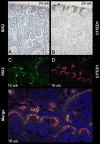SIX2 and CITED1, markers of nephronic progenitor self-renewal, remain active in primitive elements of Wilms' tumor
- PMID: 22703800
- PMCID: PMC3377935
- DOI: 10.1016/j.jpedsurg.2012.03.034
SIX2 and CITED1, markers of nephronic progenitor self-renewal, remain active in primitive elements of Wilms' tumor
Abstract
Purpose: SIX2 and CITED1 are transcriptional regulators that specify self-renewing nephronic progenitor cells of the embryonic kidney. We hypothesized that SIX2, which promotes and maintains this stem cell population, and CITED1 remain active in Wilms' tumor (WT).
Methods: To evaluate expression domains and the pathogenic significance of SIX2 and CITED1 across WT, the Children's Oncology Group provided 40 WT specimens of stages I to IV (n = 10 per stage), which were enriched for unfavorable histology (n = 20) and treatment failure (relapse or death, n = 20). SIX2 and CITED1 protein expression was evaluated qualitatively (immunohistochemistry) and quantitatively (Western blot, or WB). Gene transcription was estimated using quantitative real-time polymerase chain reaction (qRT-PCR).
Results: SIX2 was visualized by immunohistochemistry in 36 (94.7%) of 38 specimens. Protein and messenger RNA expression of SIX2 were quantitatively similar across all stages of disease (P = .48 WB; P = 0.38 qPCR), in favorable or unfavorable histology (P = 0.51 WB; P = 0.58 qPCR), and in treatment failure or success (P = 0.86 WB; P = 0.49 qPCR). Although CITED1 expression paralleled SIX2 qualitatively, no quantitative correlation between SIX2 and CITED1 expression was observed (Spearman correlation coefficient, 0.28; P = 0.08). As in the fetal kidney, overlapping, but also distinct, WT cellular expression domains were observed between SIX2 and CITED1.
Conclusion: SIX2 and CITED1 remain active across all disease characteristics of WT. Activity of these genes in WT potentially identifies a population of self-renewing cancer cells that exhibit an embryonic, stemlike phenotype. Taken together, these transcriptional regulators may be fundamental to WT cellular self-renewal and may represent targets for novel therapies that promote terminal differentiation.
Copyright © 2012 Elsevier Inc. All rights reserved.
Conflict of interest statement
Figures





References
-
- Saxen L, Sariola H. Early organogenesis of the kidney. Pediatr Nephrol. 1987;1:385–92. - PubMed
Publication types
MeSH terms
Substances
Grants and funding
LinkOut - more resources
Full Text Sources
Medical
Molecular Biology Databases
Research Materials

